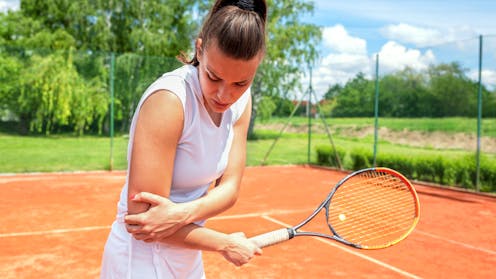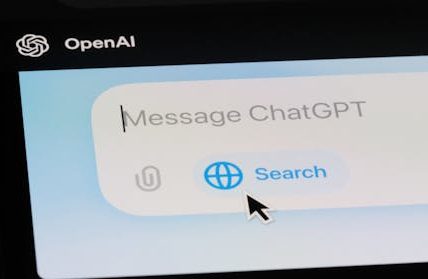Wimbledon and British Open competitors aren’t the only ones at risk of these common elbow injuries
Even those who don’t play sports are at risk of tennis elbow. didesign021/ Shutterstock
Professional athletes from around the world spend years training to compete in some of the UK’s biggest summer sporting tournaments: Wimbledon and the British Open. But not all tournament hopefuls will make it to the finals — and some may even be forced to drop out due to a variety of sporting injuries, from torn anterior cruciates to strained shoulders.
Their elbows are at risk too. In fact, two of the most common reasons for elbow pain relate to sporting injuries — the aptly named (and dreaded) tennis and golfer’s elbow.
But it isn’t just professional athletes who are at risk of developing these common elbow injuries. Even those of us sitting on the sidelines or watching from our couches can find ourselves struck down by them – even if we don’t participate in either of these sports.
In general practice, we see patients with elbow conditions fairly frequently. Elbows can become swollen as a result of repetitive strain, gout and can be fractured by a fall.
Get your news from actual experts, straight to your inbox. Sign up to our daily newsletter to receive all The Conversation UK’s latest coverage of news and research, from politics and business to the arts and sciences.
Tennis and golfer’s elbow are also common reasons people visit their GP. Both share root causes, arising from inflammation and degeneration of the forearm tendons, which attach either side of the elbow. These typically cause pain on the sides of the joint, which can radiate down the affected side toward the wrist. Establishing which side is injured is crucial to diagnosis.
The reason these conditions are associated with sports is because of the actions that are typical when playing them – the same actions which can result in injury.
Take tennis and one of its killer moves: a lethal backhand stroke, which was part of the tournament-winning arsenal of champions such as Roger Federer, Justine Henin and Stan Wawrinka. Tennis elbow seems to be more strongly associated with the one-handed backhand, affecting the outer side of the elbow.
The cause of tennis elbow can be pinpointed to a poor technique in the backhand stroke or grip. Problems with equipment, such as an incorrectly strung or a too-heavy racquet, might also exacerbate the problem.
Notably, this problem is actually observed less frequently in professional players compared to recreational players. This is probably because of their expertise, form and access to the best equipment and physiotherapy.
Golfer’s elbow refers to pain on the inner side, closest to the body. One action that can cause it is the golfer’s swing, where the player contracts their arm muscles to control the trajectory of the club. Doing so with poor technique or incorrect grip can irritate and damage the tendons. The golfer’s swing uses different muscles to a backhand stroke, so the injury occurs on the opposite side of the elbow.
Both conditions have some overlapping symptoms despite affecting different tendons. For instance, some patients may note pain when using their wrist – such as turning a doorknob or shaking someone’s hand. It can be also be present at rest too – affecting other simple functions, such as using a keyboard.
Tennis elbow is around five to ten times more common than golfer’s elbow, since these tendons are used more frequently in sport and daily life.
Confusingly, the conditions are actually not exclusive to these sports. Some golfers can develop tennis elbow, while some tennis players can develop golfer’s elbow. This is because both games feature a combination of techniques that can affect the tendons on either side.
Other sports that might also lead to a similar type of elbow injury include throwing sports (such as javelin), and batting or other racket sports – including baseball, cricket or squash. Weightlifting moves such as deadlifts, rows and overhead presses can also put considerable strain on the elbows too.
Construction workers may be at particular risk of developing tennis or golfer’s elbow.
PeopleImages.com – Yuri A/ Shutterstock
You can even develop golfer’s or tennis elbow without taking part in either of these sports. Certain hobbies and occupations which strain or damage the tendons come into play here. Workers who are heavy lifters or use vibrating machinery, such as carpenters, sheet metal workers or pneumatic drill operators, are prime candidates.
Treating a sore elbow
If you develop golfer’s or tennis elbow, standard protocol is to “rice” – rest, ice, compress and elevate. Painkillers such as paracetamol and ibuprofen can also help. In many cases, symptoms resolve themselves within a few weeks.
Depending on the severity of the injury, you may also be sent to physiotherapy or given an elbow support or splint. For really severe cases that aren’t getting better with the usual remedies, more invasive treatment is needed.
Steroid injections into the affected area can act to reduce inflammation – but have variable effects, working better for some patients than for others.
Autologous blood injection is a therapy where blood is taken from the patient and then re-injected into the space around the elbow. The thought behind this rather odd-sounding treatment is that the blood induces healing within the damaged tendon. The method is now undergoing a renaissance – and a variation of it, which uses platelet-rich plasma derived from the blood sample.
Surgery is possible, too – but is generally reserved for severe, non-responsive cases or those where a clear anatomical problem (such as damaged tendons or tissue) are causing the symptoms.
Whether or not you’re a tennis or golf pro, persistent elbow pain isn’t normal. It’s best to speak to your doctor to figure out the cause so you can get back to the court or putting green.
Dan Baumgardt does not work for, consult, own shares in or receive funding from any company or organisation that would benefit from this article, and has disclosed no relevant affiliations beyond their academic appointment.



